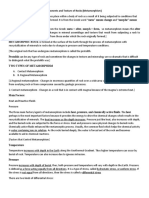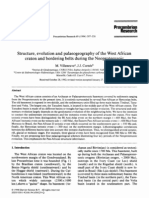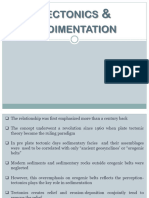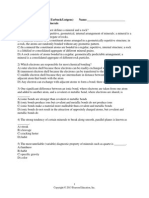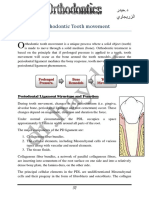Engineering Geology 1st Unit
Engineering Geology 1st Unit
Uploaded by
SaikrupaVempatiCopyright:
Available Formats
Engineering Geology 1st Unit
Engineering Geology 1st Unit
Uploaded by
SaikrupaVempatiOriginal Description:
Copyright
Available Formats
Share this document
Did you find this document useful?
Is this content inappropriate?
Copyright:
Available Formats
Engineering Geology 1st Unit
Engineering Geology 1st Unit
Uploaded by
SaikrupaVempatiCopyright:
Available Formats
Introduction and Scope
1
Introduction and Scope
1.1 INTRODUCTION TO GEOLOGY
Geology (in Greek, Geo means Earth, Logos means Science) is a branch of science dealing with the
study of the Earth. It is also known as earth science. The study of the earth comprises of the whole
earth, its origin, structure, composition and history (including the development of life) and the nature of
the processes. The word was first used in 1778 in the work of Jean Andrea de Luc (a Swiss-born
scientist who lived at Windsor for much of his life as adviser to Queen Charlotte) and at much the same
time in the work of Swiss Chemist, S.B. Saucer.
Geology is a fascinating subject.
Geology feels the pulse of the earth.
Geologists contribute their part to the nation through the discovery of new deposits of rocks and
minerals of economic value.
A student should know what lies beneath the crust and how long back the earth came into existence.
1.2 DIFFERENT BRANCHES OF GEOLOGY
For studying the earth in detail, the subject of Geology has been divided into various branches as
follows:
(i)
(ii)
(iii)
(iv)
(v)
(vi)
(vii)
(viii)
Physical Geology
Crystallography
Mineralogy
Petrology
Structural Geology
Stratigraphy
Paleontology
Historical Geology
(ix)
(x)
(xi)
(xii)
(xiii)
(xiv)
(xv)
Economic Geology
Mining Geology
Civil Engineering Geology
Hydrology
Indian Geology
Resources Engineering
Photo Geology
A Textbook of Applied Engineering Geology
(i) Physical Geology
As a branch of geology, it deals with the various processes of physical agents such as wind, water,
glaciers and sea waves, run on these agents go on modifying the surface of the earth continuously.
Physical geology includes the study of Erosion, Transportation and Deposition (ETD).
The study of physical geology plays a vital role in civil engineering thus:
(a) It reveals constructive and destructive processes of physical agents at a particular site.
(b) It helps in selecting a suitable site for different types of project to be under taken after studying
the effects of physical agents which go on modifying the surface of the earth physically,
chemically and mechanically.
(ii) Crystallography
As a branch of geology, it deals with the study of crystals. A crystal is a regular polyhedral form
bounded by smooth surfaces.
The study of crystallography is not much important to civil engineering, but to recognize the minerals
the study of crystallography is necessary.
(iii) Mineralogy
As a branch of geology, it deals with the study of minerals. A mineral may be defined as a naturally
occurring, homogeneous solid, inorganically formed, having a definite chemical composition and ordered
atomic arrangement. The study of mineralogy is most important.
(a) For a civil engineering student to identify the rocks.
(b) In industries such as cement, iron and steel, fertilizers, glass industry and so on.
(c) In the production of atomic energy.
(iv) Petrology
As a branch of geology it deals with the study of rocks. A rock is defined as the aggregation of
minerals found in the earths crust.
The study of petrology is most important for a civil engineer, in the selection of suitable rocks for
building stones, road metals, etc.
(v) Structural Geology
As a branch of geology, it deals with the study of structures found in rocks. It is also known as
tectonic geology or simply tectonics.
Structural geology is an arrangement of rocks and plays an important role in civil engineering in the
selection of suitable sites for all types of projects such as dams, tunnels, multistoried buildings, etc.
(vi) Stratigraphy
As a branch of geology it deals with the study of stratified rocks and their correlation.
(vii) Paleontology
As a branch of geology, it deals with the study of fossils and the ancient remains of plants and animals
are referred to as fossils. Fossils are useful in the study of evolution and migration of animals and plants
through ages, ancient geography and climate of an area.
Introduction and Scope
(viii) Historical Geology
As a branch of geology, it includes the study of both stratigraphy and paleontology. Its use in civil
engineering is to know about the land and seas, the climate and the life of early times upon the earth.
(ix) Economic Geology
As a branch of Geology, it deals with the study of minerals, rocks and materials of economic importance
like coal and petroleum.
(x) Mining Geology
As a branch of geology, it deals with the study of application of geology to mining engineering in such
a way that the selection of suitable sites for quarrying and mines can be determined.
(xi) Civil Engineering Geology
As a branch of geology, it deals with all the geological problems that arise in the field of civil engineering
along with suitable treatments. Thus, it includes the construction of dams, tunnels, mountain roads,
building stones and road metals.
(xii) Hydrology
As a branch of geology, it deals with the studies of both quality and quantity of water that are present
in the rocks in different states(Conditions). Moreover, it includes:
(a) Atmospheric water,
(b) Surface water, and
(c) Underground water.
(xiii) Indian Geology
As a branch of geology, it deals with the study of our motherland in connection with the coal/petroleum,
physoigraphy, stratigraphy and economic mineral of India.
(xiv) Resources Engineering
As a branch of geology deals with the study of water, land, solar energy, minerals, forests, etc. fulfill
the human wants.
(xv) Photo Geology
As a branch of geology deals with the study of aerial photographs.
1.3 RELATIONSHIP OF GEOLOGY WITH OTHER BRANCHES OF SCIENCE
AND ENGINEERING
In order to carry out civil engineering projects safely and successfully, geology should be related to the
other branches of bordering sciences as described as follows:
A Textbook of Applied Engineering Geology
1. Geochemistry
As a branch of science, it deals with geology in such a way that it concerns with the abundance and
distribution of various elements and compounds in the earth.
2. Geophysics
As a branch of science, it is related with geology in such a way that it concerns with the constitution of
the earth and the nature of the physical forces operating on with in the earth.
3. Geohydrology
As a branch of science, it is related with geology in setting of ground water. In other words, Geohydrology
is an interaction between Geology and Hydrology.
4. Rock Mechanics
As a branch of science, it is related with geology in dealing with the behaviour of rocks that is subjected
to static and dynamic loads (force fields).
5. Mining Engineering
Geology is related to mining engineering in dealing with the formation and distribution of economic
minerals and response to fracturing processes. With out the knowledge of structural features of rock
masses and mode of occurrence and mineral deposits, a mining engineer cannot determine the method
of mining.
6. Civil Engineering
Before constructing roads, bridges, tunnels, tanks, reservoirs and buildings, selection of site is important
from the viewpoint of stability of foundation and availability of construction materials. Geology of area
is important and rock-forming region, their physical nature, permeability, faults, joints, etc. Thus, geology
is related to civil engineering in construction jobs with economy and success.
1.4 IMPORTANCE OF GEOLOGY FOR CIVIL ENGINEERING
The role of geology in civil engineering may be briefly outlined as follows:
1. Geology provides a systematic knowledge of construction materials, their structure and
properties.
2. The knowledge of Erosion, Transportation and Deposition (ETD) by surface water helps in
soil conservation, river control, coastal and harbour works.
3. The knowledge about the nature of the rocks is very necessary in tunneling, constructing
roads and in determining the stability of cuts and slopes. Thus, geology helps in civil engineering.
4. The foundation problems of dams, bridges and buildings are directly related with geology of
the area where they are to be built.
5. The knowledge of ground water is necessary in connection with excavation works, water
supply, irrigation and many other purposes.
6. Geological maps and sections help considerably in planning many engineering projects.
Introduction and Scope
7. If the geological features like faults, joints, beds, folds, solution channels are found, they have
to be suitably treated. Hence, the stability of the structure is greatly increased.
8. Pre-geological survey of the area concerned reduces the cost of engineering work.
1.5 SCOPE OF GEOLOGY
Engineering Geology: A well established interdisciplinary branch of Science and Engineering has a
scope in different fields as outlined below:
(a) In Civil Engineering: Geology provides necessary information about the site of construction
materials used in the construction of buildings, dams, tunnels, tanks, reservoirs, highways
and bridges. Geological information is most important in planning phase (stage), design phase
and construction phase of an engineering project.
(b) In Mining Engineering: Geology is useful to know the method of mining of rock and mineral
deposits on earths surface and subsurface.
(c) In Ground Water: Resources development geology is applied in various aspects of resources
and supply, storage, filling up of reservoirs, pollution disposal and contaminated water disposal.
(d) Land pollution.
(e) Nuclear explosion.
(f) Oceanography.
(g) Space exploration.
In each of the above-mentioned fields Geology has to deal with an integral part of the earth.
1.6 EARTH AS A PLANET
The earth is a planet belonging to the solar system of the Milky Way Galaxy, with a natural satellite, the
moon. It is the third planet from the Sun. The planet on which we live is called the earth. There is a lot
of disagreement between the scientists regarding the shape of the earth. In recent times a new phrase
being used is that the earth is like a GEOID (Greek, GEO = earth, OID = like) i.e., our planet is like the
earth. They believe that the interior of the earth is shrinking day by day. This shrinkage may be either due
to loss of heat or reorganization of molecules under enormous pressure and high temperature. It is thus
obvious that the outer portion must shorten its circumference to adjust the shrunken interior.
Table 1.1 Chart of the diameter and the area of the earth, according to the present state of
knowledge about it
Equatorial Diameter
Polar Diameter
Floor area of the Sea 70.78%
Area of the Land
12,757 kms
12,714 kms
381 million sq. kms
149 million sq. kms
7,926.7 miles
7,900.0 miles
139.4 million sq. miles
57.5 million sq. miles
Total
510 million sq. kms
196.9 million sq. miles
A Textbook of Applied Engineering Geology
1.7 STRUCTURES AND COMPOSITION OF EARTH
The outer envelopes of the gaseous material surrounding the earth are called atmosphere. Under the
atmosphere is our earth on which we live. That part of the earth, which is in the form of a land, is
known as the earths crust. It also includes the highest peaks of mountains and floors of the oceans.
Part of the land, which is visible on the Globe, is called the Lithosphere (Greek, Litho = Stone).
We know that nearly 75 per cent of the whole surface of the earth is covered with natural waters
like oceans, seas, lakes, rivers etc. Which is in the form of more or less, a continuous envelope around
the earth. This envelope of water is called Hydrosphere (Greek, Hudous = Water). Thus, Lithosphere
and Hydrosphere in a combined form is known as the Earths crust. Under the Earths crust is the
interior of the Earth. It is further sub-divided into three shells. Depending upon the nature, the material
is made up as shown in the Fig. 1.1.
Ionospher or Radio engineers scale
Stratospher
Troposphere or Lapse rate
Atmosphere
Crust
Outer core
Mantle
or Pyrosphere
Inner
core
km
or
1300
nife
21
70
28
km
km
60 km thick crust
00
29
km
0 km
6370
km
507
40
Fig. 1.1 (a) Exhibiting the earths interior as well as exterior
The earth is composed of different rocks. In an ordinary sense the term rock means something hard
and resistant but the meaning of the word has been extended so as to include all natural substances of
the Earths crust, which may be hard like granite or soft like clay and sand. It has been estimated that
95 per cent of the Earths crust is made up of primary i.e., first formed (Igneous) rocks which is mostly
composed of Granite having Quartz, Feldspar, Biotite mica and Hornblende in varying proportions the
Introduction and Scope
remaining 5 per cent of the crust is made up of Secondary (Sedimentary or Metamorphic) rocks (as
shown in Fig. 1.2). The Earths crust is in the form of a very thin layer of solidified rocks and is
heterogeneous in nature. These rocks may be classified on the basis of their density into the following
two groups:
1. Sial (Si = Silicon and Al = Aluminium) having density 2.75 to 2.90.
2. Sima (Si = Silicon and Ma= Magnesium) having density 2.90 to 4.75.
Atmosphere
Crust
2900
Mantle
km
2840 + 60 km
6370 km
km
1300
Inner
core
2170
Outer
core
5070 km
km
2900 km
60 km
Fig. 1.1 (b)
Diagram of a wedge of earth showing the major zones and boundaries
Continents
Continental
Shelf
Continental slope
Sea level
Granite rocks
Earths crust
(density 2.7)
Basalt layer (density 3.0)
Mantle
Ultra basic rocks in mantle
Mohorovicic discontinuity
Fig. 1.2
Diagram showing the X-Section of continent and ocean basins
A Textbook of Applied Engineering Geology
It has been estimated that the Sial rocks are about 70 per cent of the Earths crust, which include
chiefly Granite and Silica. These rocks are generally on the upper regions of the crust.
Sima rocks include heavy and dark coloured rocks like Basalts. In these rocks, the percentage of
Silica is reduced and Magnesium attains the next importance in place of Aluminium of Sial rocks. These
rocks are generally found on the floors of the Oceans and beneath sial rocks.
Mantle: It is the part of the earth below the crust and surrounding the core. The imaginary line that
separates the lithosphere from the mantle is known as Moho (Mohorovicic discontinuity). Because of
high temperature and great pressure, the mineral matter in this part is the molten condition.
Core: It is the innermost layer of the earth; it extends from below the mantle (Gutenberg discontinuity)
to the central part of the earth. On the basis of earthquake waves, the core has been further divided into
two cores.
(a) Outer core
(b) Inner core
The outer core is 2,250 km thick and surrounds the core. It is believed that it is still in molten
condition.
The inner core is also called Nife because it consists of Nickel and iron. Its thickness is about
1,228 km. It is very hard in nature.
Table 1.2 Thickness and composition of different layers of the earth
Layers of the earth
1. Crust: Sial
Sima Moho
(Mohorovicic Discontinuity)
2. Mantle or
Pyrosphere
Lower Mantle
Upper Mantle
Core or Barysphere
Outer core or Mesosphere
Inner core or Nife
Thickness
Composition
0 60 km
Silicon, Aluminum
Silicon, Magnesium
60 2900 km
Silicon,
Magnesium,
Iron and Nickel
Gutenberg Discontinuity
2900 km to 5150 km
5150 km to 6378 km
Nickel and Iron
1.8 HIGHLIGHTS
l
l
Geology as a branch of Natural Science is concerned with the Earths surface as well as subsurface.
Geology as a wide tree has the several branches such as Physical Geology, Crystallography,
Mineralogy, Petrology, Structural Geology, Stratigraphy, Paleontology, Indian Geology, Civil
Engineering Geology and Mining Geology.
Introduction and Scope
l
Geology plays a vital role in the field of civil engineering and choosing suitable sites for reservoirs
and in the construction of dams, tunnels and mountain roads, etc.
QUESTION BANK
1. How is Geology related to engineering? Discuss the scope and application of the geological knowledge
in planning and execution of civil engineering works.
2. Give different branches of Geology and their application to engineering. Discuss the importance of
geology in the field of civil engineering.
You might also like
- Concepts of Stratigraphy: Sharik Shamsudhien 183104008No ratings yetConcepts of Stratigraphy: Sharik Shamsudhien 18310400817 pages
- Week 4. Igneous, Sedimentary and Metamorphic RocksNo ratings yetWeek 4. Igneous, Sedimentary and Metamorphic Rocks2 pages
- Fundamental Principles of GeomorphologyNo ratings yetFundamental Principles of Geomorphology38 pages
- Sedimentology and Stratigraphy Exam Review - Fall 2011 GEOS 315No ratings yetSedimentology and Stratigraphy Exam Review - Fall 2011 GEOS 3158 pages
- Graham J. Borradaile, M. Brian Bayly Auth., Graham J. Borradaile, M. Brian Bayly, Chris McA. Powell Eds. Atlas of Deformational and Metamorphic Rock FabricsNo ratings yetGraham J. Borradaile, M. Brian Bayly Auth., Graham J. Borradaile, M. Brian Bayly, Chris McA. Powell Eds. Atlas of Deformational and Metamorphic Rock Fabrics549 pages
- Igneous & Metamorphic Petrology Lecture NotesNo ratings yetIgneous & Metamorphic Petrology Lecture Notes17 pages
- The Volcanic and Magmatic Evolution of Volc N Ollag e A High K Late Quaternary Stratovolcano in The Andean Central Volcanic ZoneNo ratings yetThe Volcanic and Magmatic Evolution of Volc N Ollag e A High K Late Quaternary Stratovolcano in The Andean Central Volcanic Zone25 pages
- Alonso-Zarza & Tanner2006 - PaleoEnvironRecCalcret and PalustNo ratings yetAlonso-Zarza & Tanner2006 - PaleoEnvironRecCalcret and Palust249 pages
- Folds, Faults, and Other Records of Rock DeformationNo ratings yetFolds, Faults, and Other Records of Rock Deformation90 pages
- What Are Folds? What Is Their Geologic Importance?100% (1)What Are Folds? What Is Their Geologic Importance?18 pages
- Application of The Mobile Metal Ion G Article1380033154 - Amedjoe and AdjovuNo ratings yetApplication of The Mobile Metal Ion G Article1380033154 - Amedjoe and Adjovu14 pages
- Understand The Present - Interpret The Past - Uniformitarianism (Present Is Key To The Past)100% (1)Understand The Present - Interpret The Past - Uniformitarianism (Present Is Key To The Past)89 pages
- Ager - Derek - The Nature of Stratigraphical Record (3rd Edition-1993) PDFNo ratings yetAger - Derek - The Nature of Stratigraphical Record (3rd Edition-1993) PDF82 pages
- Essentials of Geology, 10e (Lutgens/Tarbuck/Tasa) Chapter 4 Volcanoes and Other Igneous Activity100% (1)Essentials of Geology, 10e (Lutgens/Tarbuck/Tasa) Chapter 4 Volcanoes and Other Igneous Activity15 pages
- Geological Maps Their Solution and Interpretation - Bolton, T - 1989 - Cambridge New York Cambridge University PressNo ratings yetGeological Maps Their Solution and Interpretation - Bolton, T - 1989 - Cambridge New York Cambridge University Press156 pages
- Geological Field Report of Kheri Murat RangeNo ratings yetGeological Field Report of Kheri Murat Range12 pages
- Geology & Soil Science - Study Material EnglishNo ratings yetGeology & Soil Science - Study Material English73 pages
- The Geotraveller: Geology of Famous Geosites and Areas of Historical InterestFrom EverandThe Geotraveller: Geology of Famous Geosites and Areas of Historical InterestNo ratings yet
- Ieee 2014 Matlab Simulations Projects List: Projec T Code Project Title YearNo ratings yetIeee 2014 Matlab Simulations Projects List: Projec T Code Project Title Year1 page
- Department of Civil Engineering Revised Course Structure For M.Tech (Structural Engineering) (DT)No ratings yetDepartment of Civil Engineering Revised Course Structure For M.Tech (Structural Engineering) (DT)13 pages
- Vendor List Version 12 (Electrical) W.E.F 01-04-2019No ratings yetVendor List Version 12 (Electrical) W.E.F 01-04-201994 pages
- Good Afternoon: CHAPTER NAME: Self IncompatibilityNo ratings yetGood Afternoon: CHAPTER NAME: Self Incompatibility30 pages
- Validation of Self Reporting Questionnaire (SRQ 20) in British Pakistani and White European Population in The United KingdomNo ratings yetValidation of Self Reporting Questionnaire (SRQ 20) in British Pakistani and White European Population in The United Kingdom14 pages
- Biolympiads Training Camps Brochure - 2023No ratings yetBiolympiads Training Camps Brochure - 202315 pages
- Leo Workshop: JSW Steels Ltd. Vijayanagara WorksNo ratings yetLeo Workshop: JSW Steels Ltd. Vijayanagara Works16 pages
- Exhaust Gas Analysis of CI Engine With Co-GeneratiNo ratings yetExhaust Gas Analysis of CI Engine With Co-Generati10 pages
- Types, Components and Features of Polyhouse PDFNo ratings yetTypes, Components and Features of Polyhouse PDF4 pages
- MX 网络16-slice Network Installation and ConfigurationNo ratings yetMX 网络16-slice Network Installation and Configuration32 pages
- EZET ACADEMY ROUTE TO PROFESSIONAL ENGINEER (Ir.) DEVELOPMENT PACKAGENo ratings yetEZET ACADEMY ROUTE TO PROFESSIONAL ENGINEER (Ir.) DEVELOPMENT PACKAGE8 pages
- Functional Textile Preferences of Elderly People PDFNo ratings yetFunctional Textile Preferences of Elderly People PDF8 pages
- Aftershokz As650sg Trekz Air Open Ear Wireless Bone Conduction Headphones Manual OriginalNo ratings yetAftershokz As650sg Trekz Air Open Ear Wireless Bone Conduction Headphones Manual Original6 pages
- Cisco Webex Meeting - User Guide (Manage Audio)No ratings yetCisco Webex Meeting - User Guide (Manage Audio)5 pages
- Concepts of Stratigraphy: Sharik Shamsudhien 183104008Concepts of Stratigraphy: Sharik Shamsudhien 183104008
- Week 4. Igneous, Sedimentary and Metamorphic RocksWeek 4. Igneous, Sedimentary and Metamorphic Rocks
- Sedimentology and Stratigraphy Exam Review - Fall 2011 GEOS 315Sedimentology and Stratigraphy Exam Review - Fall 2011 GEOS 315
- Graham J. Borradaile, M. Brian Bayly Auth., Graham J. Borradaile, M. Brian Bayly, Chris McA. Powell Eds. Atlas of Deformational and Metamorphic Rock FabricsGraham J. Borradaile, M. Brian Bayly Auth., Graham J. Borradaile, M. Brian Bayly, Chris McA. Powell Eds. Atlas of Deformational and Metamorphic Rock Fabrics
- The Volcanic and Magmatic Evolution of Volc N Ollag e A High K Late Quaternary Stratovolcano in The Andean Central Volcanic ZoneThe Volcanic and Magmatic Evolution of Volc N Ollag e A High K Late Quaternary Stratovolcano in The Andean Central Volcanic Zone
- Alonso-Zarza & Tanner2006 - PaleoEnvironRecCalcret and PalustAlonso-Zarza & Tanner2006 - PaleoEnvironRecCalcret and Palust
- Folds, Faults, and Other Records of Rock DeformationFolds, Faults, and Other Records of Rock Deformation
- What Are Folds? What Is Their Geologic Importance?What Are Folds? What Is Their Geologic Importance?
- Application of The Mobile Metal Ion G Article1380033154 - Amedjoe and AdjovuApplication of The Mobile Metal Ion G Article1380033154 - Amedjoe and Adjovu
- Understand The Present - Interpret The Past - Uniformitarianism (Present Is Key To The Past)Understand The Present - Interpret The Past - Uniformitarianism (Present Is Key To The Past)
- Ager - Derek - The Nature of Stratigraphical Record (3rd Edition-1993) PDFAger - Derek - The Nature of Stratigraphical Record (3rd Edition-1993) PDF
- Essentials of Geology, 10e (Lutgens/Tarbuck/Tasa) Chapter 4 Volcanoes and Other Igneous ActivityEssentials of Geology, 10e (Lutgens/Tarbuck/Tasa) Chapter 4 Volcanoes and Other Igneous Activity
- Geological Maps Their Solution and Interpretation - Bolton, T - 1989 - Cambridge New York Cambridge University PressGeological Maps Their Solution and Interpretation - Bolton, T - 1989 - Cambridge New York Cambridge University Press
- The Geotraveller: Geology of Famous Geosites and Areas of Historical InterestFrom EverandThe Geotraveller: Geology of Famous Geosites and Areas of Historical Interest
- Ieee 2014 Matlab Simulations Projects List: Projec T Code Project Title YearIeee 2014 Matlab Simulations Projects List: Projec T Code Project Title Year
- Department of Civil Engineering Revised Course Structure For M.Tech (Structural Engineering) (DT)Department of Civil Engineering Revised Course Structure For M.Tech (Structural Engineering) (DT)
- Vendor List Version 12 (Electrical) W.E.F 01-04-2019Vendor List Version 12 (Electrical) W.E.F 01-04-2019
- Good Afternoon: CHAPTER NAME: Self IncompatibilityGood Afternoon: CHAPTER NAME: Self Incompatibility
- Validation of Self Reporting Questionnaire (SRQ 20) in British Pakistani and White European Population in The United KingdomValidation of Self Reporting Questionnaire (SRQ 20) in British Pakistani and White European Population in The United Kingdom
- Exhaust Gas Analysis of CI Engine With Co-GeneratiExhaust Gas Analysis of CI Engine With Co-Generati
- MX 网络16-slice Network Installation and ConfigurationMX 网络16-slice Network Installation and Configuration
- EZET ACADEMY ROUTE TO PROFESSIONAL ENGINEER (Ir.) DEVELOPMENT PACKAGEEZET ACADEMY ROUTE TO PROFESSIONAL ENGINEER (Ir.) DEVELOPMENT PACKAGE
- Functional Textile Preferences of Elderly People PDFFunctional Textile Preferences of Elderly People PDF
- Aftershokz As650sg Trekz Air Open Ear Wireless Bone Conduction Headphones Manual OriginalAftershokz As650sg Trekz Air Open Ear Wireless Bone Conduction Headphones Manual Original






